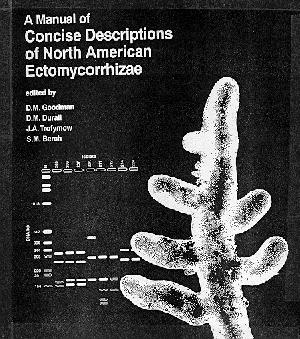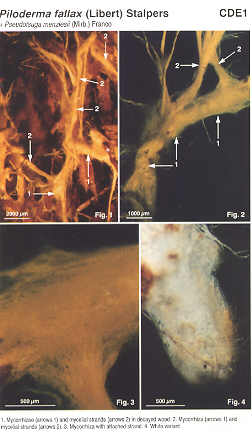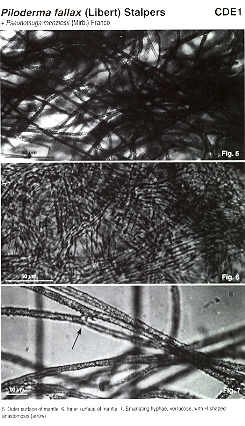Sample images from
A Manual of Concise Descriptions of North American Ectomycorrhizae
Cover picture


Piloderma fallax (Libert) Stalpers: CDE1
(Stereales, Atheliaceae)
+ Pseudotsuga menziesii (Mirb.) Franco
-bright yellow colour
-coarsely felty mantle of felt prosenchyma
-abundant undifferentiated mycelial strands
-hyphae 3 µm wide
-finely verrucose
-clampless, with H-shaped anastomoses
MORPHOLOGY (Dissection Microscope):
ECTOMYCORRHIZAL SYSTEM:
Shape and dimensions: irregular systems up to 18 mm long; tips bent; 480
(470-500) µm wide
Colour and texture: (Figs. 1-4) bright yellow or rarely white, slightly brownish,
coarsely felty, matte; mantle completely obscures host surface
EMANATING ELEMENTS:
Mycelial Strands: (Figs. 1-4) common, bright yellow, slightly brownish, hairy,
diffuse systems of interconnected filaments, round in cross-section, frequently branching
at narrow angles, attached to mantle at narrow angles, 170-600 µm diameter
Hyphae: (Figs. 1-4) common, tortuous
MANTLE IN PLAN VIEW: Mantle of medium thickness, Hartig net present, specialized
cells not seen
Outer Layer: a felt prosenchyma (Fig. 5), matrix materials not seen, cells 2.8
(2.5-3) µm wide; hyphae yellow, finely verrucose, with clear contents; septa common, not
clamped; hyphal junctions common; anastomoses common, H-shaped, not clamped
Inner Layer: a net prosenchyma (Fig 6); cells 2 µm wide, yellow, smooth, with
clear contents; septa common, not clamped, hyphal junctions common, anastomoses not seen
MYCELIAL STRANDS IN PLAN VIEW: Undifferentiated; hyphae 2 µm wide, yellow, finely verrucose, with clear contents; septa common, not clamped; hyphal junctions common; anastomoses common, H-shaped, not clamped
EMANATING HYPHAE: (Fig. 7) common, 3 µm wide, yellow, finely verrucose, with clear contents; septa common, not clamped; hyphal junctions common; anastomoses common, H-shaped, not clamped
CYSTIDIA: not seen
OTHER FEATURES:SCLEROTIA AND MICROSCLEROTIA: not seen
CHLAMYDOSPORES: not seen
AUTOFLUORESCENCE OF WHOLE TIPS: none
CHEMICAL REACTIONS: no reaction of whole ectomycorrhizae to KOH, Melzer's,
sulfovanillin, ethanol, lactic acid, or FeSO4
DNA: ITS1/NL6Bmun: Alul: 360,260,192,150,122; Hinfl: 312,186,176,168; Rsal: 769,
244,177
ADDITIONAL CHARACTERS: none observed
COLLECTION AND IDENTIFICATION: Collected by D.M. Goodman (PHDSN28/EM3) 9 November 1992, near the Koksilah River on Vancouver Island, 48o39'20" N by 123o45'50" W; described by D.M. Goodman. Identified by D.M. Goodman: matches description of P. croceum + Fagus sylvatica by Agerer (1993); P. fallax is the only golden species of Piloderma in North America, and is synonymous with P. bicolor (Peck) Jülich sensu Jülich and P. croceum J. Erikss. & Hjortstam (Ginns and Lefebvre 1993, Larsen 1983, Smith et al. 1996, Stalpers 1984); accessioned in herbarium as DAVFP 25169.
ECOLOGY: One of the most abundant ectomycorrhizae found in old-growth (288, 441 year) and mature (87, 89 year) stands of Douglas-fir at two sites in the Coastal Western Hemlock dry maritime (CWHxm) biogeoclimatic zone, site series "03 - FdHw salal" on southeastern Vancouver Island (Green and Klinka 1994), elevation 450-630 m; twenty-one collections of 600 tips total were made almost exclusively from decaying wood, some tips in fragmented litter, not found in the mineral soil, active in both May and November.
AUTHORS: Goodman D.M., and Trofymow, J.A., Canadian Forest Service, Pacific Forestry Centre, 506 Burnside Rd. W., Victoria, British Columbia, Canada, V8Z 1M5. E-mail: dgoodman@pfc.forestry.ca or ttrofymow@pfc.forestry.ca. Ph. 604 363-0677. Fax 604 363-0797.
DATE OF PUBLICATION: 1996
REFERENCES:
Agerer, R. (Editor) 1987-1995. Colour atlas of ectomycorrhizae. Einhorn-Verlag Eduard Dietenberger GmBH Swabish Gmund, Munich.
Ginns, J., and Lefebvre, M.N.L. 1993. "Lignicolous corticioid fungi of North America," Mycologia Memoir 19, APS Press, St. Paul, Minnesota.
Green, R .N., and Kiinka, K. 1994. A field guide to site identification and interpretation for the Vancouver Forest Region. (285 p.) Government of British Columbia, MOF Research Branch, Victoria, B.C.
Larsen, M.J. 1983. "On Piloderma bicolor in North America and its relationship to Piloderma byssinum." Mycologia 75:1092-1093.
Stalpers, J.A. 1984. "A revision of the genus Sporotrichum." Stud. Mycol., Baarn 24:1-105.
Smith, J.E., Jumppoven, A., Larsen M.J., McKay, D. 1996. Ecology and taxonomy of Piloderma spp.: a golden indicator of old-growth forest soil legacy. Abstract, First International Conference on Mycorrhizae, Berkeley, California, August 4-10, 1996. http://mendel.berkeley.edu.boletus/abstracts/smith2.html -DEAD LINK.
Go back store